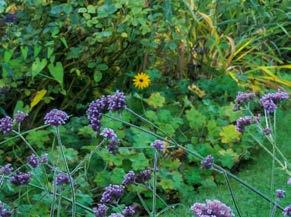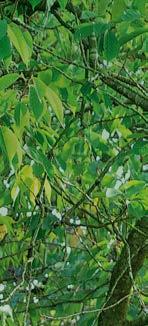







































































This month, Jim Cable is revitalising a tired bed of daylilies, crocosmia and bergenias, tackling bindweed, planning for next year and planting broad beans

It’s time to tackle a section of the long bed at the Deanery. Planted by a previous occupant, it is a classic mixed border of shrubs and herbaceous perennials. In my sights is a section of 6m 2 dominated by daylilies, crocosmia and bergenias. The latter two were very shy to flower this year, no doubt due to congestion. The daylily did bloom, but you can have too much of a good thing and it is concealing an underlying weed problem. My morning inspection would often reveal a coil of bindweed scrambling into the light from deep within a clump. I would carefully unravel the intruder and yank it out, but this is only a temporary solution. All three plants have good foliage. The bergenia is evergreen and its bold leathery leaves completely suppress weeds. The daylilies and crocosmia contrast beautifully with
bergenia with a good root system and plant in two patches near the front of the border. The daylily satisfyingly pulls into individual crowns with a fan of rhizomatous roots at their base. These I plant to make three groups near but behind the bergenia. Each crocosmia has a string of corms with the oldest at the base. Sprouting sword-shaped leaves at the top is this year’s baby, showing white and plump through a papery skin. I discard the older corms replanting only the youngster. Again, I plant in three areas associating with the bergenia but leaving space between it and the daylily for a contrasting subject – perhaps an achillea with flattopped sprays of flowers from June to September. Or maybe a bold single dahlia such as ‘Lou Farman’.
it but bring the same grassy texture to the summer party. The composition needs adjusting and space creating to add some new characters for next year.
I choose a fi ne day and use a spade and a large fork to cut and lift the three swathes of plants placing large chunks onto a tarpaulin on the lawn. I then fork over the bed using the tines as a sieve and removing every piece of fleshy white bindweed root I can fi nd. If this were a large estate garden, I would leave the area fallow for a year to allow any remaining bindweed to make itself known. This would entail potting up the lifted plants and caring for them in a nursery in the interim. My nursery area is small and always crammed with treasures, so I must clean the roots of the lifted plants, as well as the ground, as thoroughly as possible and replant straight away.


The three plants require slightly di erent approaches – although in each case the most vigorous looking sections come from around the edges of the old clumps, so I concentrate on harvesting these. I use a knife to cut sections of

Choosing what to plant in the newly organised section will be an indoor winter project. I take a tape measure out to the bed and sketch the layout of existing plants noting the dimensions and position of each clump. Maybe I am making work for myself, creating a cosy job to keep me motivated during the dark months, but I like to draw a scale diagram and make copies so I can play around with di erent schemes. Creating a succession of interest through the year requires thought and a surprising number of plants. But this is not yet the time for armchair gardening. I like to sow broad beans in October. They will crop earlier next year than the ones I sow in spring. I use large module trays, since mice enjoy the seeds when I direct sow. I favour the varieties ‘De Monica’ and ‘Luz de Otono’ for autumn sowing although ‘Aquadulce Claudia’ is the traditional choice. They germinate quickly in the coldframe and I acclimatise them to the autumn elements before planting them out in a space currently occupied by my tomatoes.

My morning inspection would often reveal a coil of bindweed scrambling into the light from deep within a clump
New plants, books, tools and creative designs, plus shopping inspiration

Cutter Brooks, the Stow-on-the-Wold shop owned by American expat Amanda Cutter-Brooks, has built up a loyal following among those in the know. With a background in the fashion industry, Amanda has a keen eye for design and her collections of homeware and fashion are gathered from smaller studios around the world: expect Indian, African and French influences. New is this tablecloth, perfect for making the most of summer in the garden. Designed by Amanda and handprinted in India, it’s available in three sizes. Bandana floral block-print tablecloth, from £160, cutterbrooks.com
The design of the box planters we now know as Versailles planters is attributed to André Le Nôtre and Jean-Baptiste de La Quintinie. Reputedly first used in King Louis XIV’s orangery, these containers enabled the royal citrus collection to be moved outdoors with the seasons without the need for transplanting. The planters are now a timeless garden element, such that Lapicida, the stone specialist, has added a range to its Ornamenti collection comprising furniture, obelisks, fountains and sundials. Versailles planter, in various finishes, from £2,500, ornamenti.co.uk

Encyclopedia of Garden Design

edited by Chris Young DK, £30
With climate resilience, sustainability and nature-friendly practices front of mind, garden design now encompasses a wave of fresh approaches. Chris Young includes these in a refreshed publication of this classic design handbook. All the invaluable elements, including guides to developing plans, building landscapes and selecting plants, remain.
Darwin and the Art of Botany by James T Costa & Bobbi Angell Timber Press, £25

A less well-known area of Charles Darwin’s work is his focus on plants: he observed essential behaviours, such as the way vines climb and plants are pollinated. This work includes his essays on these topics and combines them with botanical art from Bunny Mellon’s Oak Spring Garden Foundation; James Costa contextualises Darwin’s writing.
Secret Gardens of Cornwall by Tim Hubbard, and Jo and Rob Whitworth Frances Lincoln, £22
Sublime images from Jo and Rob Whitworth, regular photographers for The English Garden, make this coffeetable book of Cornish gardens an escapist delight. Writer Tim Hubbard’s skilful exploration of the gardens and their owners adds to the enjoyment.

Sarah Raven, whose eponymous brand is based on colourful cut flowers, shares her love of all things bright and beautiful in her gloriously vibrant gardens at Perch Hill in East Sussex
 WORDS JACKY HOBBS PHOTOGRAPHS JONATHAN BUCKLEY
WORDS JACKY HOBBS PHOTOGRAPHS JONATHAN BUCKLEY



Alison Green’s experimental approach has resulted in a perfectly proportioned series of garden rooms at Theobalds Farmhouse in Middlesex, where balance is both a driving force and a central motif


WORDS ZIA ALLAWAY PHOTOGRAPHS ANNA OMIOTEK-TOTT


















Fife’s Falkland Palace was once home to Scottish royalty and its formal gardens host a range of fine trees, Arts & Crafts borders and an orchard of regional fruits all suffused in the warm glow of autumn














 This image Anaphalis and asters in a bed by Percy Cane; an Acer griseum glows in the distance. Opposite Vitis coignetiae spills over an urn.
This image Anaphalis and asters in a bed by Percy Cane; an Acer griseum glows in the distance. Opposite Vitis coignetiae spills over an urn.
The tantalising barrier presented by a beautifully planted and calmly reflective moat offers us a lesson we can apply to our own gardens, says Non Morris


At its finest, a moated garden will make you smile and sigh the moment you arrive at the water’s edge. There is a wistful intensity to the shimmering, broken-up reflection of the planting on the banks above that cannot fail to affect you.
Smudged clouds of yellowgreen chartreuse suspended below sunny billows of Euphorbia characias, soft dashes of silver dancing in the emerald ripples beneath the pale uprights of Artemisia ludoviciana ‘Valerie Finnis’. The reflected south facade of the fairy-tale 14th-century Markenfield Hall near Ripon is crazily beautiful and highly charged with emotion, as if the voluptuous high-summer planting and the memory of all summers past are present at the same time.
If you find yourself in a moated garden and the light is good, the experience will be unforgettable. I will always remember arriving at Helmingham Hall in Suffolk on a July evening. I was taking part in the Garden Museum Literary Festival and there was a small party for the speakers. The light was golden and the rosé in my glass somehow the same delicate pink as the prettiest flowering rush, Butomus umbellatus, planted in swathes at the water’s edge like lightest puffs of shell-pink against the shiny water.
These days there is a particular softness to the planting on the banks of the moat that wraps around the 16th-century hall. The succession of topiaried yew is hazy with wildflower meadow and the birdsong is heartfelt and celebratory. The reflection of the building looms and recedes soothingly as you stroll on the soft grass and, as with all the best moats, there is always an enchanting arched bridge – mirrored immaculately in the inky water – to invite you on to explore a different part of the garden.
Bridges are, of course, key. They create a sense of drama and add to the romance. At Markenfield, a crisscross wooden bridge takes you from the demure north frontage (brought to life by the soft yellow rambler Rosa ‘Malvern Hills’, which flowers for months and is perfect for a shady aspect) and leads you through a foaming sea of cow parsley and the taller, more willowy wild parsnip to the orchard beyond. There are lessons to be learned for our own moatless gardens: discover how attractive a well-designed point of transition can be, when you know there is something tantalising beyond but cannot yet see it.
Naturally glorious with the abundance of summer, moats can be relied upon to magnify the beauty of every season. The reflection of the pale, elegant medieval manor house Columbine Hall, also in Suffolk, shimmers all year round in its surrounding moat. In spring, a sheet of clematis spills over an ancient brick wall and casts an apple-blossom-coloured raft on the water below. In winter both banks and water are fiery with the willow Salix alba var. vitellina ‘Nova’ – simple planting that’s dazzlingly effective.
As part of our long-term mission to move out of town, my husband and I once looked at a dilapidated farmhouse enchantingly reflected in a moat that began just steps away from the front door. Inside, the basement was flooded and the wallpaper damp and peeling. I’m afraid we ran a mile. Perhaps of all garden aspirations a moat is not one to add to your list. Instead, seek out an idyllic moated garden or two to visit and bask carefree in its layered allure. n
markenfieldhall.com; helmingham.com; columbinehall.co.uk
There is a wistful intensity to the shimmering, broken-up reflection of the planting on the banks above